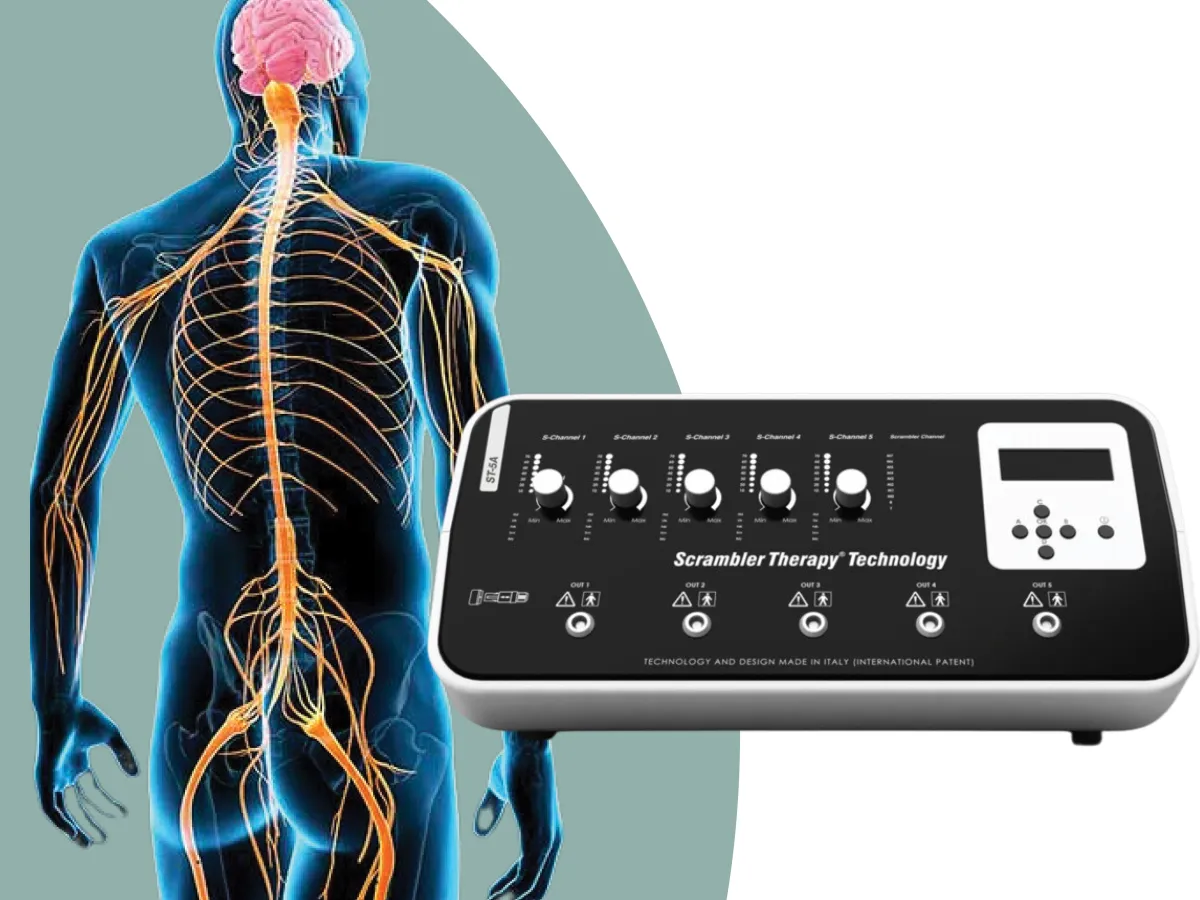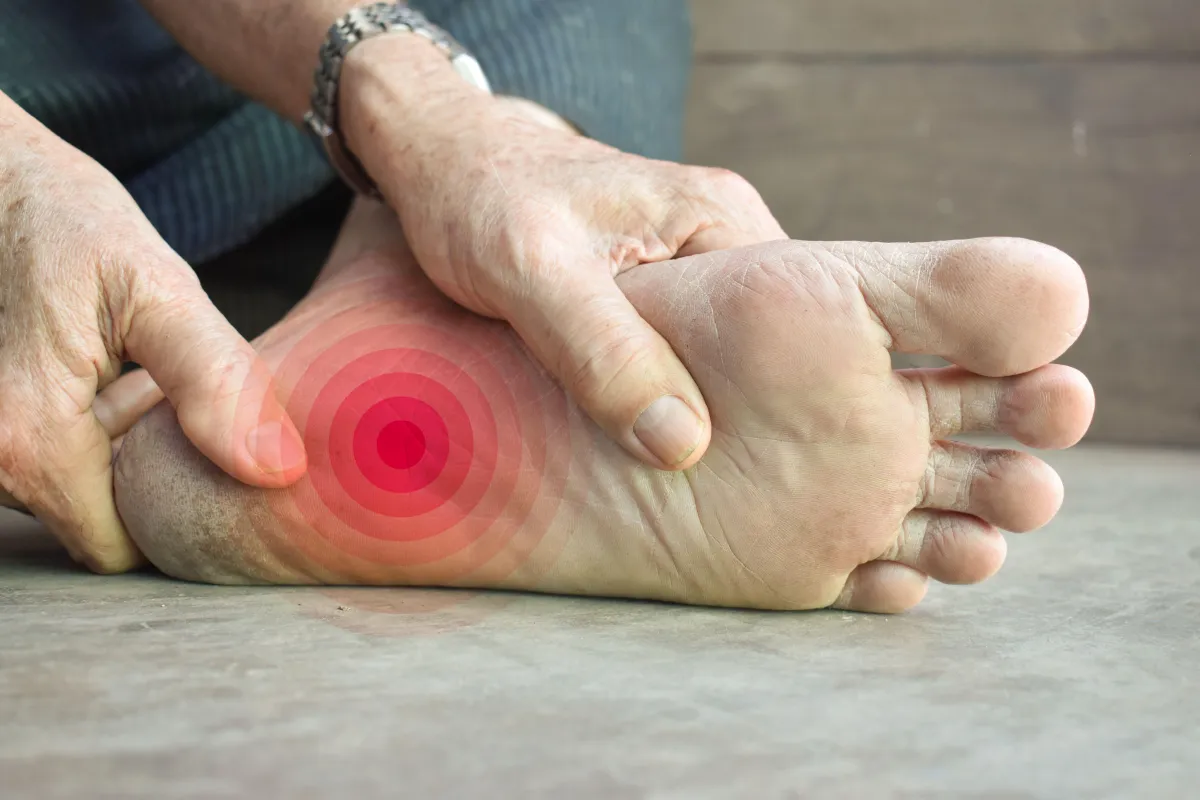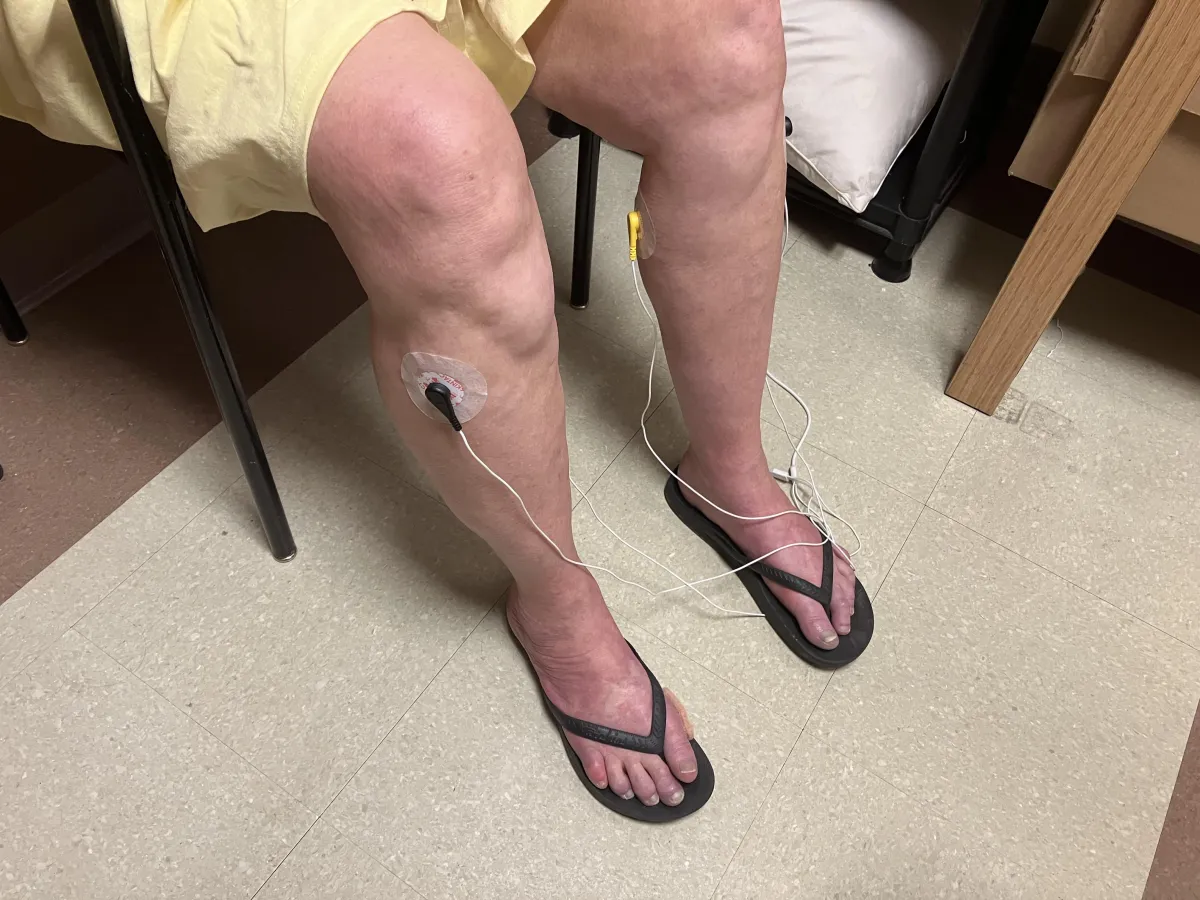Finally, an EFFECTIVE non-opioid, non-invasive way to treat Chronic Pain
Scrambler Therapy's 80%-90% effectiveness in treating chronic neuropathic and oncologic pain gives you an unparalleled ability to care for your patients

Introducing Cutting-Edge Advancement in Chronic Pain Relief: Scrambler Therapy® Technology
Scrambler Therapy® ST-5A Technology is a revolutionary electroanalgesia device
Uses a biophysical (instead of biochemical) approach to treat chronic pain.
Transmits a “no pain” message to the surface receptors via disposable electrodes
Remodels the pain system to convey a message of “no pain” to the central nervous system.
As Seen in:



"80-90% of patients have a favorable response," states
The New England Journal of Medicine, July 2023
Scrambler Therapy® Technology Effective Chronic Pain Relief
Gives Hope to Patients with No Adverse Side Effects.
Discover a Wide Variety of Indications for Use

*Note: Scrambler Therapy is effective in treating most types of neuropathic and oncologic pain. Diagnosis listed to the right are some examples that Scrambler Therapy can treat. Book a call to explore diagnosis not listed.
Indications for Use
Chronic neuropathic pain
Chronic opioid-resistant pain
Chronic oncologic pain
Diagnosis Able to Treat:*
Complex Regional Pain Syndrome (CRPS)
Pancreas and abdominal cancer pain
Post-herpetic pain (shingles pain)
Bone metastases
Spinal cord stenosis
Post-mastectomy pain
Chemotherapy-induced Peripheral Neuropathy (CIPN)
Chronic Cancer Pain
Chronic Neuropathic Pain
Failed Back Surgery Syndrome (FBSS)
Sciatic and Lumbar Pain
Post herpetic Neuralgia (PHN)
Brachial Plexus Neuropathy
Low Back Pain (LBP)
Chronic Neuropathic Pain Opioid Addiction
Endometriosis
Understand the Treatment Behind Our
Solution for Chronic Pain
Employs 5 artificial neurons connected to electrodes to treat multiple pain areas simultaneously
By overriding the pain signal with a “no pain” signal to the brain, it scrambles (recodes) the neurons, reducing the patient’s pain level to zero regardless of the initial pain intensity and type
The treatment protocol typically includes 10 consecutive sessions over two weeks
Each session is ~45 minutes each
Booster sessions are provided as needed
Use is restricted to physicians (MD/DO) or to other qualified health care professionals under the direct supervision of a physician

Insights from Medical Experts
Hear What Doctors Have to Say About Our Exceptional Medical Device

"It's effective, it's non-invasive, it reduces opioid use
substantially and it can be PERMANENT."
- Thomas Smith, M.D., professor of oncology and medicine at the
Johns Hopkins University School of Medicine
Listen to Dr Salahadin Abdi, MD, head of pain management at MD Anderson Cancer Center who led some of the clinical trial locations share his insight:
For more clinical information, please visit:
Your Patients Will Love Scrambler Therapy Too!
"For over 22 years, right hip pain plagued me due to Osteoarthritis. Medications like Norco® and a Fentanyl Patch left me sluggish and drugged. When the pain spread to my back and hands, meds weren't an option anymore. My doctor mentioned Scrambler Therapy®. After 6 months of waiting, I tried it. To my disbelief, the first treatment relieved my pain. My fingers went from claw like to functional, and life became manageable again. I restore antiques using my hands daily, and Scrambler Therapy® changed everything. Boosters make me feel even better. It's like a miracle—I've regained "ME." I cycle, ski, and live fully."
Gloria B. / Sandy, OR
"After my second session of Scrambler Therapy, I was at home and got up from a chair and got halfway across a room before I realized what I was doing. I Didn’t have any pain. I Didn’t struggle. I Didn’t grab my cane. I Didn’t think that was ever going to be possible again in my life.”
Tom / Portland, OR
"My chronic pain was so intense I lost my will to live. Over 30 doctors tried to alleviate the pain, but they could only provide slight, temporary relief. Over a two year timespan I went to over 350 medical visits, and had so many tests, injections, and nerve blocks I lost count. Then I learned of Scrambler Therapy. It sounded too good to be true given all the disappointments - I didn't believe there could be anything that could help. After 3 treatments I could walk normally again. By the end of the 10th treatment my pain was gone. Scrambler Therapy treatments, quite literally, saved my life."
Connor C. / McKinney, TX
“Had no hope of getting relief from the diabetic neuropathy in my feet. Now the pain,
burning and sensitivity is gone. Amazing.”
Bill / Portland, OR
"I felt so hopeless and helpless with my daughters chronic pain that was leaving her debilitated. Every option seemed worse than the next…surgery…possible addiction…drugs that would reduce her ability to live her life normally. We refused them all and we’re determined to grind it out with PT in hopes the pain would subside. We heard about scrambler therapy around 8 months into her ordeal. I was all for it…she was not. She was understandably afraid of it making her worse and also of me having paid the cost of it and it not working. Finally she agreed to at least give it a try. At first it really didn’t seem to be her answer. She experienced some relief, but it was minimal and short lived. We were encouraged by the stories of others success however so we decided to stick it out a while longer. On day nine while on the machine my daughter looked up and said that her pain was a “zero”. We got in the car to go home…both emotional. She looked me in the eye and said “it’s gone”. Chills ran down my spine. “What do you mean” I asked. “I mean it’s gone Mom. It’s not coming back.” She was right; it was gone and it has not come back. Scrambler therapy was nothing short of a miracle treatment for my daughter. There isn’t a day that goes by that I am not grateful for her having her life back pain free."
Connor C. / McKinney, TX
U.S. Locations
There are over 80 locations using Scrambler Therapy across the US today including:
16 Military and VA Hospitals
Research Hospitals: Mayo Clinic, Johns, Hopkins, MD Anderson, Cleveland Clinic, UCLA
Numerous Private Practices
(click on the map to open a Google Map)

EXCLUSIVE CONVENIENT TRAINING
IN YOUR OFFICE
FOR YOUR CONVENIENCE, WE OFFER 3 DIFFERENT OPTIONS FOR TRAINING:
"On-site" in your office - WE CATER TO YOU
BOISE, IDAHO
ROME, ITALY
Training is conducted over a 3-day period, ensuring each provider is given a wide variety of patients and diagnosis to treat. Both the science and the "art" of electrode placement and device functionality is covered in detail.
MAKE A PROFIT WITHIN THE FIRST 2 WEEKS!
Scrambler Therapy adds a new, billable procedure to your office with it's own CPT code. Our "Placement Agreement" structure offers a one-time, upfront cost of $4,999 for Training and Setup and a per-treatment fee, allows for your office to be profitable within weeks or months of starting treatments. Couple the Placement Agreement with the On-Site Training and you'll realize a profit Blog Postsafter the first 2 week!

Tingling, Numbness, and Burning: Decoding Chronic Pain
Living with tingling, numbness, or burning sensations can degrade your quality of life, leaving you feeling isolated and desperate for relief. In your search for answers, you might wonder what is really at the root of your pain. So many doctors you see can offer traditional pain solutions, but they just seem like bandaids that have risk of side effects, recovery times, and endless medical expenses. Still... you might wonder if it is worth it. You might have got here because you're still looking for answers.
We're here to help ensure chronic pain doesn't take over your daily life. We'll help you identify whether the pain you're struggling with is neuropathic or mechanical and if Scrambler Therapy™ is the revolutionary treatment that can help you get back to all the things you love in life!
Chronic Pain Vs Acute Pain?
Understanding the difference between chronic and acute pain is needed to take the necessary steps to get help to take the pain away. While all pain can be excruciating, some types linger long beyond the other and can wreak havoc on your life.
What is Acute Pain?
Acute pain is your body's immediate response to an injury or illness. It's a sharp, sudden sensation triggered by a specific event, such as a cut, burn, or fracture. When you experience acute pain, your nervous system sends rapid signals to your brain, alerting you to potential harm. This type of pain typically comes with pretty instant visible signs like swelling, redness, inflammation, and bruising, indicating that your body is actively healing the affected area. Acute pain resolves as the body heals, and it is managed with treatments to reduce inflammation and promote recovery.
What is Chronic Pain?
Chronic pain is much different. It persists for months or even years, long after the initial injury has healed. Conditions like arthritis, nerve damage, and back problems are common sources of chronic pain. Unlike acute pain, chronic pain involves prolonged activation of the nervous system. Nerve fibers continue sending pain signals to your brain even without an active injury. This ongoing pain signaling leads to heightened sensitivity and incredible discomfort, making everyday activities feel unbearable. Chronic pain has a huge emotional toll that can cast a shadow across your life, adding to the total impact.
Identifying Types of Chronic Pain Such as Neuropathic Or Mechanical Pain
Chronic pain can be categorized into several types, each affecting your body in distinct ways and for different reasons. Here are a few we wanted to cover with you today:
Neuropathic Pain
Neuropathic pain arises from damage or dysfunction in the nervous system. It can result from conditions like diabetes, multiple sclerosis, or nerve injuries. Your nerves send faulty signals to your brain, making you feel tingling, burning, and numbness without an obvious cause.
Oncologic Pain
Oncologic pain is associated with cancer and its treatments. It can result from the tumor itself pressing on bones, nerves, or other organs, or from the side effects of chemotherapy, radiation, or surgery.
Mechanical Pain
Mechanical pain, often referred to as musculoskeletal pain, stems from damage to the muscles, ligaments, or joints. Common conditions include arthritis, herniated discs, and muscle strains. This type of pain is usually worsened by movement and can greatly limit your mobility. Scrambler Therapy™ is limited in treating this type of pain.
Common Symptoms of Neuropathic Pain
Tingling or "Pins and Needles" Sensations: This uncomfortable feeling starts in your hands or feet, creating a sensation as if you’re being pricked by tiny needles. It can make everyday tasks, like typing or walking, extremely unpleasant.
Numbness: A loss of sensation in the affected areas. You might not feel a touch, pressure, or even temperature changes, which can lead to a sense of disconnection from your body.
Burning Pain: This is a persistent, searing pain that feels like your skin or deeper tissues are on fire or a lighter is being held to the skin. It can occur in any part of your body, making even rest and relaxation difficult.
Shooting or Electric Shock-like Pain: Sudden, sharp pains that shoot down your arms or legs can catch you off guard, causing intense discomfort and anxiety about when the next jolt might strike.
Increased Sensitivity: Even light touches or mild temperatures can cause extreme pain. This hypersensitivity, known as allodynia, can make wearing clothes or feeling a breeze agonizing.
Weakness or Paralysis: Damage to your nerves can lead to muscle weakness or even paralysis in severe cases. This affects your ability to perform basic activities, adding to the frustration and feelings of helplessness.
Common Symptoms of Oncologic Pain
Persistent Aching: This is a continuous, dull pain that doesn’t seem to go away. It can be constant or fluctuate in intensity, often making it hard to concentrate or find relief.
Sharp, Stabbing Pain: You can experience sudden, intense pain in specific areas. This sharp pain can be triggered by certain movements or seemingly appear out of nowhere, causing intense waves of distress.
Burning Sensation: Similar to neuropathic pain, a burning sensation can affect areas impacted by cancer or its treatment. It feels like your skin is constantly on fire.
Deep, Throbbing Pain: When cancer spreads to the bones, it can cause a severe, throbbing pain that penetrates deeply, often interfering with everything from sleep to normal daily activities.
Electric Shock-like Pain: Chemotherapy can damage nerves, leading to sharp, shooting pains that feel like electric shocks. These sudden jolts of pain can occur unexpectedly, making simple tasks like reaching for an object or even slight movements excruciatingly painful. This type of pain disrupts daily activities and can add to the emotional and physical burden of dealing with cancer.
Pressure or Fullness: Tumors pressing on organs or other structures can create a sensation of intense pressure or fullness. This can be incredibly uncomfortable and may cause additional symptoms like nausea or difficulty breathing.
Common Symptoms of Mechanical Pain
Stiffness: This is often felt in the morning or after periods of inactivity. Your joints or muscles feel rigid, making it hard to move freely. This stiffness can gradually improve with movement but often returns after rest.
Localized Pain: You may experience pain in a specific area, such as your lower back, neck, or knees. This pain is usually related to movement or certain positions.
Aching or Throbbing: This type of pain can be persistent and dull, creating a continuous, uncomfortable sensation. It often worsens with activity and can make simple tasks, like walking or lifting objects, challenging.
Muscle Weakness: Damage or strain in your muscles can lead to a feeling of weakness, making it difficult to perform tasks that require strength. This weakness can affect your stability and increase the risk of further injury.
Swelling and Inflammation: Injuries or conditions affecting your joints or muscles can cause noticeable swelling and inflammation. This can lead to a feeling of tightness and heat in the affected area.
It’s important to not use this article to diagnose yourself, but to use it as a tool to help you evaluate what is happening in your body so you can seek out the medical attention you need. It’s also important that you know all of your options when it comes to treatment so you can navigate the conversation in the way that resonates best with you.
Treatment Options and Side Effects for Chronic Pain
Choosing the right treatment for chronic pain can be daunting, especially when considering the risks and benefits. Each option has its unique positives and negatives, some of which can be a big "NO" from you, depending on your situation. From huge costs, low effective rates, and even addiction, it's important to go into conversations with your medical provider with a great base knowledge of your options so you can tailor the conversation to get exactly what you feel is best for you!

From the comparison chart, you can see just how innovative and safe Scrambler Therapy™ truly is. It’s FDA approved and has re-shaped the lives of so many chronic pain sufferers who lost their zest for life while trying to deal with the tingling, numbness, and burning sensations that they just couldn’t escape. Scramble Therapy resolves the burning pain and a heavy decrease in the numbness and tingling once the burning pain subsides.
Want to find out more? Check out our FAQ blog here and talk to your doctor about access to Scrambler Therapy™!
© 2024 Erickson Strong Medical - All Rights Reserved
